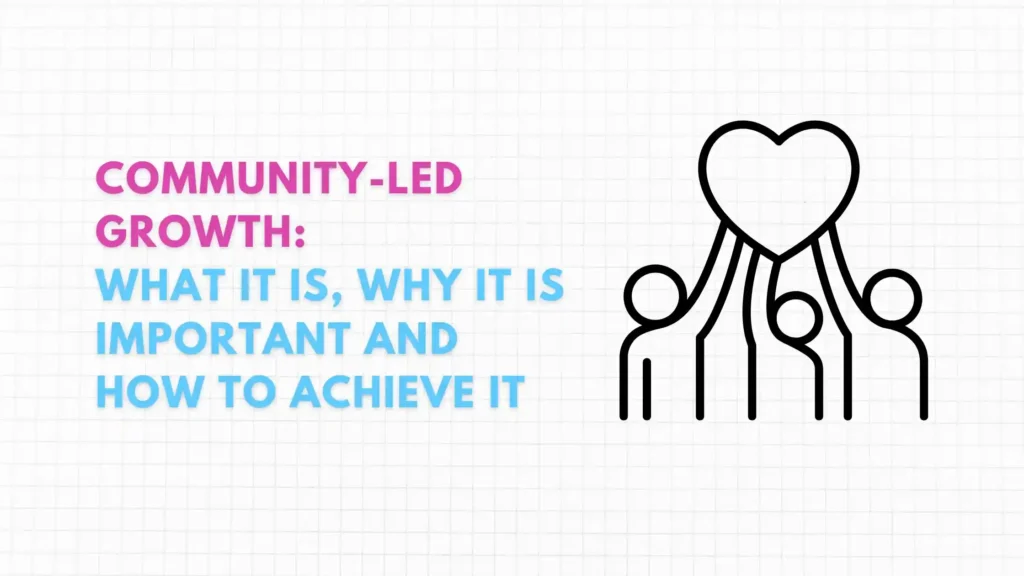Whether your brand has 20 or 1 million customers, you have your own brand loyalists and supporters. This is where you tap to build a community and harvest its benefits.
These are the people who trust your brand, products, plans, and strategies. They are the ones who, at times, without an incentive, promote you.
And guess what! You may not think, but they desire to be engaged even more with your brand and be part of your “magic”.
So how do you nurture and harness human curiosity and willingness to increase your brand engagement to drive up (CLV) Customer Lifetime Value? This is where Community led growth comes in.
It’s time to dive into the topic more. I will cover community and product-led growth strategies, the benefits and types of communities, along with excellent examples to inspire you.
What is exactly community-led growth?
Community-led growth strategy in marketing refers to an approach where marketing efforts are centered around building and engaging a community of customers or stakeholders to drive business growth.
It involves creating a community of loyal and engaged customers actively involved in the marketing process, fostering a sense of belonging and ownership, and leveraging their support to achieve marketing objectives.
For each type of company, Community-led growth creates uncounted benefits. Still, it is a powerful strategy specifically for Consumer Packaged Goods (CPG) Companies, Retail Businesses, Brands in Fashion, Cosmetics, Fast Food, Sports and Sports teams, Travel and Hospitality.
Why has community-led growth become popular?
Funnel vs. Flywheel
The rise of community-led growth in recent years can be attributed to changes in customer interactions with brands. Traditional marketing strategies, depicted by the funnel metaphor, focused on optimizing each step of the purchasing process in a linear manner, from awareness to advocacy.
However, with evolving customer behaviors, the funnel metaphor has become less relevant in describing the customer journey. Brands now recognize the need to nurture leads, even after conversion to customers, in order to foster loyalty and extend customer lifetime value (CLV).
The four stages of the CLG flywheel are:
- Awareness – when the customer becomes aware of the brand
- Consideration & Sales – the brand initiates the process of nurturing potential customers to set itself apart and establish a unique identity
- Post-sales – the brand maintains efforts to nurture the customer even after the purchase has been made, by providing networking opportunities and showcasing ongoing value
- Advocacy – the customer refers the brand to their peers, thereby initiating a new cycle
Rather than forcing individuals towards a definite outcome, a community creates a captivating atmosphere that draws people toward its center. This attraction is what transforms them into advocates and supporters of the community. The process is comparable to a flywheel; by consistently engaging and retaining customers, they can eventually become advocates and promote the community to others. As a result, the traditional funnel becomes a virtuous circle that decreases acquisition costs and prioritizes the community’s importance.
Product-led growth vs. community-led growth
Product-led growth (PLG) and community-led growth (CLG) are distinct approaches to driving growth and engagement in different contexts. What are the differences between these two?
Product-led growth (PLG) focuses on leveraging the product itself as the primary driver of growth. It involves building and delivering a compelling product experience that creates value for users and encourages them to advocate for the product, thereby driving organic growth through user acquisition, retention, and expansion. PLG typically relies on product-driven metrics and strategies, such as product usage, product adoption, user referrals, and virality.
On the other hand, community-led growth (CLG) emphasizes the active participation and engagement of local communities in decision-making, planning, and implementation of development initiatives. It involves empowering communities to take ownership of their own development and driving positive change from within. CLG typically involves inclusive and participatory decision-making processes, community-driven project design, and building local capacities and institutions. CLG often focuses on social and economic development in local communities, emphasizing sustainability, inclusivity, and local ownership.
While both PLG and CLG share some similarities in terms of promoting engagement and ownership, they are distinct in their focus and context. PLG is primarily focused on driving growth and engagement in the context of technology products or services, often in the realm of software-as-a-service (SaaS). In contrast, CLG is focused on community-driven development initiatives in local communities. PLG is often used in the context of business and technology startups, while CLG is commonly applied in the context of international development, community development, and social impact initiatives.
Why is community-led growth a successful strategy?
Community is an inherent and crucial aspect of the human experience. Active participation in a dynamic community provides us with a sense of identity and inclusion, allowing us to foster meaningful connections, share personal experiences, and support the ongoing growth of individuals, ourselves, and the world around us.

A community can be anything from a physical place where people geographically connect or via a virtual space such as social media groups or private community platforms. Communities bring like-minded people together with similar characteristics and common interests. Every community operates with specific boundaries to meet the needs of that community. Being a part of a community can make us feel like we are a part of something greater than ourselves.
This is the reason behind the growing power of community-led growth strategies. Indeed, 49% of businesses with online communities report annual cost savings of 10% to 25%.
With strong virtual communities, better things are possible than just cost savings. 58% of marketers concluded that virtual events produced the best results for their content marketing in the last 12 months.
The benefits of a Community-led growth marketing strategy
Community-led growth is a powerful approach that benefits both brands and customers. Brands can build a network of passionate customers who influence others to purchase, driving growth and acquisition. Meanwhile, customers who are part of a community, find added value in the product or service, as they can learn from and engage with fellow customers at their own pace. This enhances customer lifetime value (CLV) and positively impacts a brand’s annual recurring revenue (ARR).

Here are more advantages to this method.
Brand Advocacy: By creating a community of enthusiastic customers, brands can harness the power of word-of-mouth marketing. Community members are likely to share positive experiences and recommendations with others, leading to increased brand advocacy and organic referrals.
Acquisition and Growth: A strong community can drive acquisition and growth as community members influence others to become customers. As more people join the community, the brand’s reach expands, leading to potential new customers and increased sales.
Enhanced Customer Lifetime Value (CLV): Being part of a community can extend the value of the product or service for customers. It fosters loyalty and engagement, increasing customer retention and repeat purchases, ultimately boosting CLV.
Valuable Customer Insights: Community-led growth allows brands to gather valuable insights from their customers. Through community interactions, brands can gain feedback, suggestions, and ideas for product improvement, leading to better customer-centric strategies.
Asynchronous and Collaborative Learning: Communities enable customers to learn from each other, providing opportunities for asynchronous and collaborative learning. Customers can exchange knowledge, share experiences, and support each other, resulting in increased product understanding and customer satisfaction.
Positive Brand Image: A vibrant community creates a positive brand image, showcasing the brand’s commitment to customer engagement and support. This can increase brand loyalty, trust, and goodwill among customers.
Impact on Annual Recurring Revenue (ARR): The growth and engagement of a community can have a healthy impact on a brand’s ARR. As the community grows, more customers will likely renew their subscriptions or make recurring purchases, increasing ARR.
Types of online communities
There are several types of online communities varying from business type and industry.
According to this source, the types of online communities can be summarized in 6 forms:
- Knowledge and learning communities
- Expert networks and advisory communities
- Event communities
- Membership communities
- Brand communities
- Communities of Action
Each form of the community may vary in structure and offers different benefits. However, they all have a common ability to gather people around a topic or a brand.
How to get started with your community-led growth strategy?
If you’re looking to jumpstart your community-led growth strategy, there are a few key steps you should take. First and foremost, it’s important to identify your target audience and understand their needs and preferences. From there, you can start to build a community around your product or service, focusing on engagement and interaction with your customers. Utilizing social media platforms and hosting events can effectively connect with your audience and foster a sense of community. Additionally, ensuring you have a clear value proposition and a strong brand identity can help differentiate your company and attract new customers. Remember, the key to community-led growth is building meaningful customer relationships and providing value beyond just your product or service.
Here are the steps in a little more detail:
Understand and define who your community is.
Start by researching and understanding your community. Who are they? What are their needs and interests? What motivates them to engage with your business? Conduct surveys, focus groups, and other forms of research to gain a deep understanding of your community. Here are more details on each step.
If you want to build a strong foundation for your strategy, the first step should be establishing your goal. Most probably, that goal should be based on the identity, mission, and characteristics of your community (e.g., acquire new clients, develop a partner network, etc.
Create a plan.
Develop a plan for your Community-Led Growth strategy. Determine the tactics you will use to achieve your goals, such as creating user-generated content campaigns and their formats, hosting events, or launching a loyalty program. Be sure also to determine how you will measure success and adjust your plan as needed.
Find the best tools to engage your community.
In today’s world, online communities are prevalent. To make your brand noticeable and foster a sense of connection, it’s crucial to produce captivating digital content. To accomplish this, you’ll need a dependable tool for planning, creating, and managing campaigns. Activation, engagement, and authenticity are vital factors when working with your community. Therefore, BrandLens is an excellent solution for brands aiming to achieve these objectives, including the creation of User-Generated Content.
Engage your community.
Begin engaging with your community by putting your tactics into action. Encourage participation and feedback, and promptly address any concerns or suggestions. Ensure that your community feels appreciated and listened to. Allow them to feel a sense of ownership over your brand by implementing their top suggested needs and following up to confirm that their needs have been met. Additionally, involve them in your digital content strategy by giving them the opportunity to co-create and share content on social media alongside you. Your customers and community are your new creators and influencers!
Measure and optimize.
Continuously measure the success of your Community-Led Growth strategy and optimize it as needed. Use data analytics to track engagement, sales, and other key metrics. Analyze the data to identify what is working and what is not, and make adjustments accordingly.
How to measure the success of a community-led growth strategy?
Measuring the success of a community can be challenging because each community is unique. There is no standard way to set goals and measure success, as what works for one community may not work for another.
When it comes to community, there are several things you should consider. The metrics to evaluate a community’s success will vary depending on the type of business and the desired community goals.
Here are some KPIs you may want to measure in your community:
Number of Visitors & Members
Counting the number of community members is the primary way to evaluate the success of a community. This metric reflects how many individuals have expressed an interest in joining the community.
Number of active community members
The number of active community members differs from the total count of community members. It only includes those who are regularly engaging and participating in the community, not those who have joined but are no longer active. Therefore, inactive members are not considered in the evaluation of the community’s success.
Sign-ups of the new members
Monitoring the number of new member sign-ups is a valuable method to evaluate the effectiveness of efforts to attract new members to the community. By tracking the monthly count of new members, it is possible to identify whether the number is increasing or decreasing, which can provide insight into the success of recruitment strategies. In case of a decrease, the reasons can be analyzed, and new approaches can be implemented to encourage growth.
Engagement
To gauge engagement in your community, there are various metrics to consider, such as shares, reactions, and comments. However, comments are particularly crucial as they indicate community members’ engagement level. The number of comments received, responses to the content shared, and the frequency of discussions held can reveal how involved people are in the community. Additionally, analyzing comments can provide insights into what users appreciate or feel is lacking within the community.
Referral traffic and conversion
Monitoring the website traffic originating from your community is essential. By establishing a link between your content and the site traffic, you can demonstrate the effectiveness of your community. This can be achieved by analyzing the traffic sources using Google Analytics or by creating landing pages that cater to your community members and tracking the number of visits through UTM links. Keeping tabs on the traffic from your community is an effective way to measure the success of your community engagement efforts.
Some popular community-led growth strategies from renowned brands
Gymshark

Gymshark, a giant British fitness apparel, utilized influencer marketing and UGC (user-generated content) to maximize customer engagement and increase CLV (Customer life value). It has become one of the fastest-growing fitness apparel brands in the world, and its growth is primarily fueled by the strong community they have built around its brand.
In 2018, the brand made a significant stride in its marketing history by launching the “66 days, Change Your Life” challenge on Tik Tok. The challenge involved customers taking photos and videos of themselves wearing GymShark apparel and sharing them on various social media platforms. The aim of the challenge was to showcase the transformation of participants’ bodies before and after using GymShark clothing. The campaign was incredibly successful, prompting the company to repeat it this year. BrandLens can help create similar campaigns for brands.
Starbucks

We all know that Starbucks sells more than coffee. The company is always focused on providing good customer experiences. And the key to this exceptional customer experience is the usage of communities and focused love toward customers’ experiences.
It’s important to note that Starbucks started the usage of UGC content back in 2016. The company focused on resharing user-generated content (UGC) through its RedCupArt campaign.
As part of a campaign, Starbucks asked customers to get creative and decorate their red cups. Thousands of people participated and shared their artwork on social media platforms like Instagram and Twitter. Starbucks showcased the best designs on its own social media channels, inspiring others to join in on the fun. This was an important move by the company to engage with its customers and encourage their creativity.
Glow Recipe

One of the strongest community-fostering industries is Cosmetics Industry. A large amount of beauty industry professionals and non-professionals are seeking product recommendations and review every day!
Glow Recipe is an innovative brand specializing in all-natural skincare products that aims to make the skincare experience enjoyable for its customers. Their website offers an extensive range of value-added content, including tutorial videos, customer reviews, skincare product recommendation quizzes, and a comprehensive Glowipedia to guide customers in achieving their desired looks. By providing this wealth of information, Glow Recipe fosters a robust brand community that offers customers much more than just face masks and cleansers.
Glow Recipe values its customers and strives to build a strong community by offering valuable content. In celebration of empowered women, Glow Recipe has introduced an interview series called “Boss Babes” which features successful female entrepreneurs. It is noteworthy that Glow Recipe’s commitment to motivation, empowerment, and confidence, which are highly valued by its customers, is reflected in the content it provides beyond its products.
Glow Miles is another program for its community members which shows how important its members are. With this VIP program customers are rewarded with early access to products and sales and invitations to events. The company’s focus on female empowerment and confidence creates a customer experience that is as beautiful as the products they offer.








